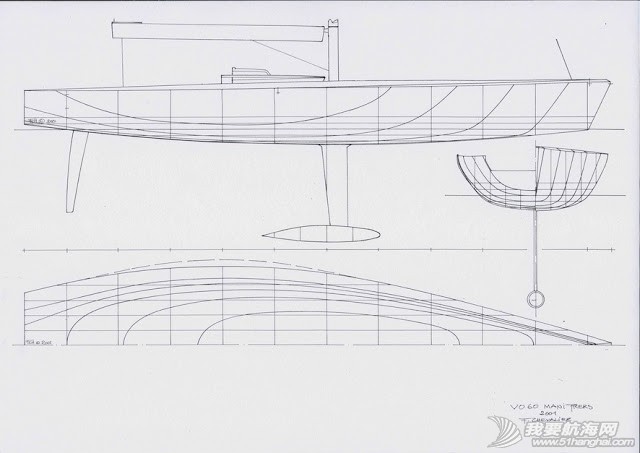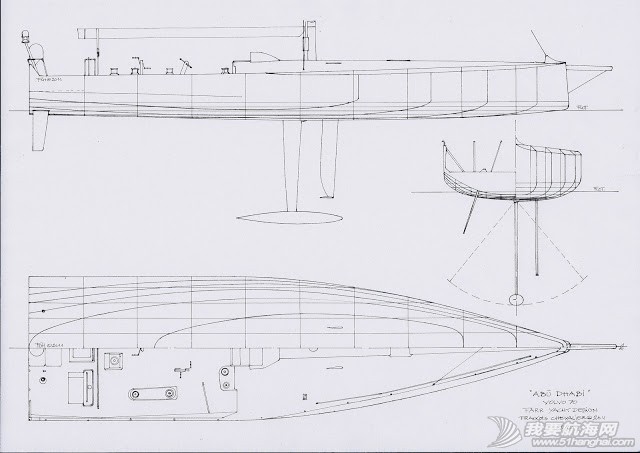登录航海网,拥抱全世界
您需要 登录 才可以下载或查看,没有账号?立即注册
x
三届沃尔沃帆船赛赛船图纸分析
VOLVO OCEAN RACE - YACHT DRAWINGS - DESIGN EVOLUTION - 2001-2002, 2005-2006 & 2011-2012
FOR THE FIRST TIME ON THE WEB
VOLVO OCEAN RACE YACHT DESIGNS - 2001 - 2012
Evolution of the Volvo yacht designs since 10 years !
To carry out these lines plans, which I drew on tracing paper, I observed the hulls in build or ex-works, using their cradles as a source at times, and all the while bearing in mind the personalities and intentions of the yacht designers who had created them and especially in strict observation of the relevant rating rules. Thus I was able to draw them fairly accurately. As soon as the sailing boats received their keels, rudders and centerboards, I was able to finalise the plans for the 2001, 2005 and 2011 editions of the Volvo Ocean Race.
2001-2002
In 2001, the new rating rule which defined the VO60 authorised carbonfiber rigging, which gave real oompff to the yachts and profoundly changed their behaviour.
Out of eight candidates, six came from Farr Design: Assa Abloy, Illbruck, News Corporation, Team SEB and Team Tyco. The team at Nautor Challenge ordered two boats, amongst which one, Amer Sport Two, was designed by Bruce Farr himself, and the other, Amer Sport One, was designed by Germán Frers, Jr., AKA “Mani Frers“. Skipper Grant Dalton held back his choise until the very last moment, when he left the Farr yacht to Lisa McDonald's all-female crew. The eighth yacht was Norwegian entry Djuice Dragons designed by Laurie Davidson.

What stands out distinctively today is the narrow beam at the waterline on the one hand, and the hollow shape of the hulls on the other. Indeed, the three designers created narrow hulls, with as much external ballast as possible, with a tapered chine-bilge, as required by the rating rule, at broadest section of the yacht.

According to Bruce Farr, a yacht must be a skimming dish designed in compliance with the rating rule. His hulls feature angular lines, rather than flowing from a free hand: the forward sections are cut into an arrowhead along a plane that follows the deck from the bow to the mast. Then comes a 50cm vertical section, which is parallel on either side and extends far aft. The final angle is featured on the topsides, starting at a 45° angle from the bottom of the keel until the chain girth measurement. The cut extends all the way to the transom.
Laurie Davidson favoured safety instead and created comprehensively buoyant forward sections, though this penalised performance because it increased developable surface. The fin of Djuice's keel seems to develop greater area than other contenders.

Mani Frers' design displays greater stiffness, with wider topsides, as well as a sharper bow. The fin of the keel, which is positioned slightly forward of the mast, favours upwind performance, although this makes the yacht chase a lot more downwind. Her sail plan is far back, and the mast is close to amidships.
It is interesting to note that all ballast has been centred down the waterline, so the centre of buoyancy is located similarly on a
Incidentally, the Farr yachts took both first and second place, and Laurie Davidson had to make do with sixth place, though taking victory in the final leg.
2005-2006
For the next edition, the Volvo Ocean Race introduced the new VO70 rule. Longer, lighter, with greater sail spread, a canting keel and the choice of twin rudders; these yachts inherited from improvements developed in the America's Cup, the TP52 as well as the IMOCA circuits.

Juan Kouyoumdjian was the champion in this competition, his ABN Amro One taking 16 out 22 races and his ABN Amro Two establishing a new 24-hour distance record. Bruce Farr's four VO70s Pirates of the Caribbean, Brasil 1, Ericsson and Movistar took up the rankings in the middle of the fleet and the Australian entry Brunel, designed by Don Jones, finished in the last place.

Juan K's designs exploited every loophole in the rating rule, creating a larger, stiffer yacht, with a very sharp wave-piercing bow, a canting keel swinging on a hinge inside the hull, increasing stiffness further in upwind conditions, a skimming hull shape in after sections, deep daggerboards, lengthier keel with a narrower section. With more power and capable of planing extensively, these hulls established themselves as the fastest and announced a new trend.

Bruce Farr sought a fine and balanced design, with a rudder in the centreline of the yacht.
As for Don Jones, serving a project with limited funds, he created a more conventional yacht, with a round and wide hull, rounded forward sections, and with a very forward mast and a centerboard more forward still, and featuring a cockpit as way aft as possible.
2011-2012

| ©François Chevalier 2012 |
I did not have the opportunity to finalise the plans that I had prepared for the 2008-2009 edition, because no magazine expressed an interest to publish the lines of all five naval architects.
For the 2011-12 edition, with three contending designers, Juan K designed half of the fleet: the American entry Puma skippered by Ken Read, the French entry Groupama skippered by Franck Cammas and the Spanish entry Telefónica skippered by Iker Martinez. Farr Yacht Design carried out the plans for Abu Dhabi and was also represented by the Chinese entry Sanya (formerly Telefónica Blue) skippered by Mike Sanderson, who won the 2006 edition of the Volvo Ocean Race. Finally, Marcelino Botin, renowned for his TP52s, drew the lines of Camper for Emirates Team New Zealand.
Surprisingly for this "box rule", the three designers have produced very different yachts. Marcelino Botin created a superb development of a TP52: narrow, extremely sleek lines with a very forward centre of gravity, beam kept back to three quarter of the boat's length and lowrise transom, huge centerboards aft of the mast, which is itself centred in the middle of yacht.

| ©François Chevalier 2012 |
Farr's design breaks away from all trends. Assuming that these yachts should plane at the slightest of breezes, but would stop brutally in short waves, their hulls should be developed to plane as early as possible, and heel when beating without too much chasing forward, in order to raise stiffness, resulting in Abu Dhabi's huge round and full bow, with a sharp cutwater and vertical topsides. Here maximum beam is reached amidships and carries all the way aft, waterline is wide and centered, lines are sleek yet smooth, wth fine and elaborate centerboards, almost vertical and nearly inline with the axis. The forward deck is very cambered and the coachroof extends into it in a completely flush fashion.

| ©François Chevalier 2012 |
Juan K has developed his previous lines and optimised on numerous advantages established in the previous edition which was won by the Swedish entry Ericsson 4. The elaborate lines are obvious in the forward sections where the chine bilge extends all the way to the bow, with flat bottoms immediately after the cutwater in order to guarantee planing and to separate from the axis of the yacht when heeling to increase stiffness. The bottom aft is shaped to espouse and lengthen the stern wave and the wake that defines critical speed. All these characteristics demonstrate stronger ability for speed than other competitors, and the three yachts designed by Juan K currently head the fleet in rankings.
However, it is to be noted that the three designers have shared the following: using the maximum beam afforded by the rating rule and fashioning keels, rudders and centerboards of similar shape.
The above lines plans have drawn for French magazine Voiles & Voiliers, but not all have been published. The last three appeared in the latest issue for the month of May, alongside commentary from a few sailors.
With regards to the damages experienced in recent legs, it must be observed in humble truth that the latest generations of yachts and shapes of yachts are developed for formidable performance such that has never been witnessed before, so the sustained impacts into head seas has only increased the stress and strain on mechanical parts and the hull itself. It is to the credit of the teams ongoing yachts if they have sustained no breakage.
Congratulations must also be handed to the sailors who have resisted so much wash on deck and so much discomfort above as well as below decks!
Please have a look on Donan Raven's blog:
nuttyrave's sailing trivia
JUAN KOUYOUMDJIAN LETTER EDITED IN SCUTTLEBUTTEUROPE N° 2568/APRIL 12th 2012 Edited with the kind Juan K's agreement
With our 3 boats safely in Brazil and under the risk of sounding arrogant, I’ll break away from my golden rule of not speaking until the end of the race to put the record straight since I believe we are presented with an intentional manipulation of the truth.
There is a common, spread notion that ALL the participants of this VOR have structural problems, that the situation is unacceptable and that something needs to be done for the future. A fundamental distinction needs to be done between the mast breakages and the rest, and whilst I think it is very important to understand what caused so many mast failures, it is a travesty of the truth to put ALL designs in the same basket when it comes down to the “other” structural issues.
This generalization might suit a specific Team, or person to push any agenda he might have for the future, but out of respect of the hard and serious work done with my Team I need to speak up.
In the first edition of the VO70s, we had 2 triumphs to celebrate that as designers we are very proud of. One is obviously that our design was driven to victory by a very good crew and the other one is that our 2 boats were the only ones that completed the full circumnavigation without major structural problems. This celebration was faded by the public generalization that because one boat sunk and others had structural failures, then ALL of the boats had problems and the rules had to be changed. Which in fact they did, for the worse! I didn’t say anything publicly then and moved on. However, seeing the same generalization occurring now, I’d like to stick to the facts and so allow for conclusions to be made without generalizations.
- A VO70 cannot be designed not to break. In fact, any boat in a round the world race cannot be designed not to break. So ultimately, breakages are in the hands of the crew.
- Puma won leg 5 without a major structural problem and this due to the excellence and experience of its crew.
- Telefonica finished 2nd in leg 5 with a hull delamination in port mid bow which did not prevent her from racing.
- Telefonica’s pit stop in Cape Horn was not a necessity but rather a very clever strategical decision based on having 3rd place assured and a weather window to exploit.
- Groupama, notwithstanding of an excellent management of the boat during leg 5 to see misfortune hit them with a broken mast, has sailed on her own means to Brazil without structural problems.
So, while we focus in understanding why there have been so many problems with the rigs, I’d beg not to generalize and avoid putting in the same basket the good work and brilliance of some engineers with that of others which are clearly not the same.
|